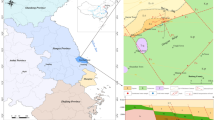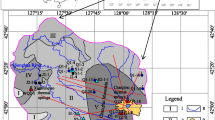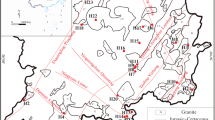Abstract
The Dabie Orogenic Belt is rich in geothermal resources, while relevant research is insufficient. To further find out the reserves of geothermal resources and their sources in the Dabie Orogenic Belt, reveal the mechanism of thermal circulations, and conduct quantitative assessments of the recharge sources, temperature of thermal reservoirs and depth of thermal circulations in the research area, on basis of thorough understanding of the geological conditions of the geothermal resources in the Dabie Orogenic Belt, four groups of geothermal water samples and six groups of underground cold water samples were collected in Xifei Geothermal Field for quantitative calculation, so as to test the hydrochemical characteristics and analyse the evolution process of geothermal water. The calculation results show that the geothermal water in Xifei Geothermal Field can be classified into SO4–Na type, and the main anions and cations in it derive from the dissolution of silicate and gypsum minerals. The data of δD and δ18O shows that the geothermal water is mainly recharged by the percolation of meteoric water. The temperature of geothermal reservoirs calculated with quartz and chalcedony geo-thermometers and by simulated multi-mineral equilibrium ranges from 85.05 to 116.31 °C.













Similar content being viewed by others
Data availability
Availability of data for this manuscript can be obtained upon enquiry to the corresponding author.
References
Adams S, Titus R, Pietersen K, Tredoux G, Harris C (2001) Hydrochemical characteristics of aquifers near Sutherland in the Western Karoo. South Africa J Hydrol 241(1–2):91–103
Alacali M (2018) Hydrogeochemical investigation of geothermal springs in Erzurum, East Anatolia (Turkey). Environ Earth Sci 77:802. https://doi.org/10.1007/s12665-018-7986-1
Battistel M, Hurwitz S, Evans WC, Barbieri M (2016) The chemistry and isotopic composition of waters in the low-enthalpy geothermal system of Cimino-Vico Volcanic District, Italy. J Volcanol Geotherm Res 328:222–229
Blasch KW, Bryson JR (2007) Distinguishing sources of ground water recharge by using δD and δ18O. Groundwater 45(3):294–308
Caracausi A, Martelli M, Nuccio PM, Paternoster M, Stuart FM (2013) Active degassing of mantle-derived fluid: a geochemical study along the Vulture line, southern Apennines (Italy). J Volcanol Geotherm Res 253:65–74
Cheng CG, Yang LB (2005) Distribution features of geothermal water resources in Anqing City and Initial Study on their development and utilization. Geol Anhui 15(3):186–189 (in Chinese with English abstract)
Cheradyntsev VV (1971) Uranium-234. Keter Press, Jerusalem, pp 44–54
Connolly CA, Walter LM, Baadsgaard H et al (1990) Origin and evolution of formation waters, Alberta Basin, Western Canada Sedimentary Basin. II. Isotope systematics and water mixing. Appl Geochem 5(4):397–413
Craig H (1961) Isotopic variations in meteoric waters. Science 133(3465):1702–1703
Criss RE, Taylor HP Jr (1986) Meteoric-hydrothermal systems. Rev Min Geochem 16:373–424
Dansgaard W (1964) Stable isotopes in precipitation[J]. Tellus 16(4):436–468
Das P, Maya K, Padmalal D (2020) Hydrochemistry, geothermometry and origin of the low temperature thermal springs of South Konkan region, India[J]. Geothermics 90:101997
Diao TR, Du F (2019) Genesis model of geothermal resources and evaluation of geothermal resources in Yuexi County, Anhui Province. Ground Water 1(6):27–28 (in Chinese with English abstract)
Du F, Pan GL (2021) A discussion on the features and formation mechanism of the Xifei Geothermal Field, Yuexi Anhui. Geol Anhui 31(2):4165–4168 (in Chinese with English abstract)
Fan Y, Pang Z, Liao D, Tian J, Hao Y, Huang T, Li Y (2019) Hydrogeochemical characteristics and genesis of geothermal water from the Ganzi Geothermal Field, Eastern Tibetan Plateau. Water. https://doi.org/10.3390/w11081631
Fournier RO (1973) Silica in thermal waters: laboratory and field investigations. In: Proceedings of international symposium on hydrogeochemistry and biogeo-chemistry. Tokyo, pp 132–139
Fournier RO (1977) Chemical geothermometers and mixing models for geothermalsystems. Geothermics 5:41–50
Gibbs RJ (1970) Mechanisms controlling world water chemistry. Science 170(3962):1088–1090
Giggenbach WF, Goguel RL (1989) Collection and analysis of geothermal and volcanic water and gas discharges. NZ DSIR Chem Report 2401:1–82
Guo Q, Liu M, Li J, Zhang X, Guo W, Wang Y (2017) Fluid geochemical constraints on the heat source and reservoir temperature of the Banglazhang hydrothermal system, Yunnan-Tibet Geothermal Province, China. J Geochem Expl 172:109–119
Isaji R, Okano O, Ohtani T, Takagi E, Sugihara Y, Ueda A (2021) Sr isotopic geochemical study of brines and rocks from a geothermal well No. 7 and surrounding hot spring waters in Okuhida Hot spring area, Gifu Prefecture, Japan. Geothermics 91:102018
Katz BG, Coplen TB, Bullen TD, Davis JH (1997) Use of chemical and isotopic tracers to characterize the interactions between ground water and surface water in mantled karst. Groundwater 35(6):1014–1028
Komatsu S, Okano O, Ueda A (2021) Chemical and isotopic (H, O, S, and Sr) analyses of groundwaters in a non-volcanic region, Okayama Prefecture, Japan: implications for geothermal exploration. Geothermics 91:102005. https://doi.org/10.1016/j.geothermics.2020.102005
Li SZ, Zhang GW, Dong SW et al (2010) Relation between exhumation of HP-UHP metamorphic rocks and deformation in the northern margin of the Yangtze Block. [J]. Acta Petrologica Sinica 26(12):3549–3562 (in Chinese with English abstract)
Li X, Qi J, Yi L, Mo Xu, Zhang X, Zhang Q, Tang Y (2021) Hydrochemical characteristics and evolution of geothermal waters in the eastern Himalayan syntaxis geothermal field, southern Tibet. Geothermics 97:102233
Lin W, Shi YH, Wang QC (2009) Exhumation tectonics of the HP-UHP orogenic belt in Eastern China: new structural–petrological insights from the Tongcheng massif, Eastern Dabieshan. Lithos 109(3–4):285–303
Liu H, Zhao GH, Song Y (2020) Study on the characteristics and reservoiring model of geothermal resources in Anhui Province. Geol Anhui 30(4):271–279 (in Chinese with English abstract)
Pan GL (2011) Characteristics of geothermal resources and the division of prospecting areas in Anhui Province. Chin J Geol Hazard Control 22(2):130–134 (in Chinese with English abstract)
Ratschbacher L, Hacker BR, Webb LE et al (2000) Exhumation of the ultrahigh-pressure continental crust in east central China: Cretaceous and Cenozoic unroofing and the Tan-Lu fault[J]. J Geophys Res Atmos 105(B6):13303–13338
Reed MH, Spycher NF (1984) Calculation of pH and mineral equilibria in hydrothermal waters with application to geothermometry and studies of boiling and dilution. Geochim Cosmochim Acta 48:1479–1492
Sasaki K, Morita J, Iwaki C et al (2021) Geochemical evaluation of geothermal resources in Toyama Prefecture, Japan, based on the chemical and isotopic characteristics of hot spring waters[J]. Geothermics 93:102071
Schoeller H (1964) La Classification Géochimique Des Eaux, vol 64. IASH publication, pp 16–24
Tardy Y (1971) Characterization of the principal weathering types by the geochemistry of waters from some European and African crystalline massifs. Chem Geol 7(4):253–271
Tian J, Pang Z, Wang Y, Guo Q (2019) Fluid geochemistry of the Cuopu high temperature geothermal system in the eastern Himalayan syntaxis with implication on its genesis. Appl Geochem 110:104422. https://doi.org/10.1016/j.apgeochem.2019.104422
Tole MP, Armansson H, Pang Z et al (1993) Fluid/mineral equilibrium calculations for geothermal fluids and chemical geothermometry. Geothermics 22:17–37
Verma SP, Santoyo E (1997) New improved equations for Na/K, Na/Li and SiO2 geothermometers by outlier detection and rejection. J Volcanol Geoth Res 79(1):9–23
Wang GL, Zhang W, Liang JY et al (2017) Evaluation of geothermal resources potential in China. Earth Sci 38(4):449–459 (in Chinese with English abstract)
Wang Y, Gu H, Li D et al (2021) Hydrochemical characteristics and genesis analysis of geothermal fluid in the Zhaxikang geothermal field in Cuona County, southern Tibet. Environ Earth Sci 80:415
Wu HQ, Yang ZD, Shu Q et al (2016) Distribution characteristics of geothermal resources in Anhui Province and their development and utilization suggestions. J Geol 40(1):176–182 (in Chinese with English abstract)
Yuan XF, Wang J, Huo G et al (2020) Hydrochemistry and genesis of the Hongshuilantang hot spring in the Jiaodong Peninsula. Geol Explor 56(2):427–437 (in Chinese with English abstract)
Zhang BB, Xu Q, Jiang CW et al (2017) Characteristics of δD and δ18O in the precipitation and evaporation sources in Anqing. Scientia Silvae Sinicae 53(12):20–29
Zhao J, Zhang W, Ma F, Zhu X, Zhang H, Wang G (2020) Geochemical characteristics of the geothermal fluid in the Rongcheng geothermal field. Xiong’an New Area. Acta Geologica Sinica 94(7):1991–2001
Zhao J, Wang G, Zhang C, Xing L, Li M, Zhang W (2021) Genesis of geothermal fluid in typical geothermal fields in western Sichuan, China. Acta Geologica Sinica (english Edition) 95(3):873–882. https://doi.org/10.1111/1755-6724.1471
Zheng YF (2008) A perspective view on ultrahigh-pressure metamorphism and continental collision in the Dabie-Sulu orogenic belt[J]. Chin Sci Bull 53(20):3081–3104
Zheng YF, Gao TS, Wu YB et al (2007) Fluid flow during exhumation of deeply subducted continental crust: Zircon U-Pb age and O-isotope studies of a quartz vein within ultrahigh-pressure eclogite. J Metamorph Geol 25(2):267–283
Zhou X, Jin XM, Liang SH et al (2017) Special Topics on Groundwater Sciences, 2nd edn. Geological Publishing House, Beijing (in Chinese)
Funding
This study was funded by the Science and Technology Innovation Fund Project (2022-4) of East China Metallurgical Geological Survey Bureau for the year 2022, the National Natural Science Foundation of China (42107162), the Natural Science Foundation of Anhui Province (1908085QD168), the Fundamental Research Funds for the Central Universities of China (PA2021 KCPY0055), and the County Economic Development Research Center of Sichuan (2022018).
Author information
Authors and Affiliations
Contributions
H.L. and D.W. wrote the main manuscript text and W.W. prepared figures 1 and 3. The production of the remaining Figures and Tables was completed by T.F. J.C.C. and P.C. X.G. Y.S. and M.J.H are responsible for the calculations in the manuscript. All authors reviewed the manuscript.
Corresponding author
Ethics declarations
Conflict of interest
The authors declare that they have no conflict of interest.
Additional information
Publisher's Note
Springer Nature remains neutral with regard to jurisdictional claims in published maps and institutional affiliations.
Rights and permissions
Springer Nature or its licensor (e.g. a society or other partner) holds exclusive rights to this article under a publishing agreement with the author(s) or other rightsholder(s); author self-archiving of the accepted manuscript version of this article is solely governed by the terms of such publishing agreement and applicable law.
About this article
Cite this article
Liu, H., Wu, D., Wei, W. et al. Study on hydrochemical characteristics of underground hot water in typical granite thermal storage and hot water development model in Dabie Mountain, Anhui Province. Environ Earth Sci 83, 138 (2024). https://doi.org/10.1007/s12665-024-11436-1
Received:
Accepted:
Published:
DOI: https://doi.org/10.1007/s12665-024-11436-1




